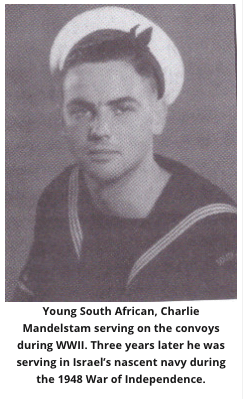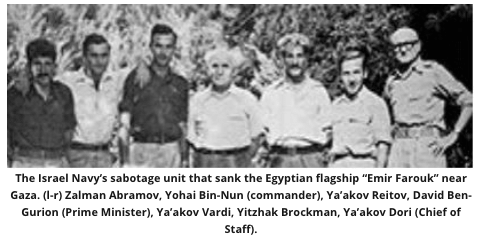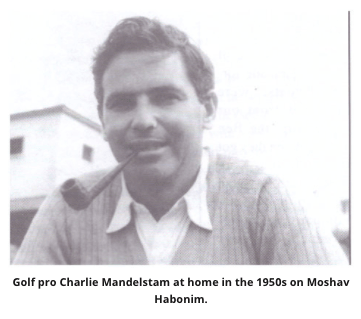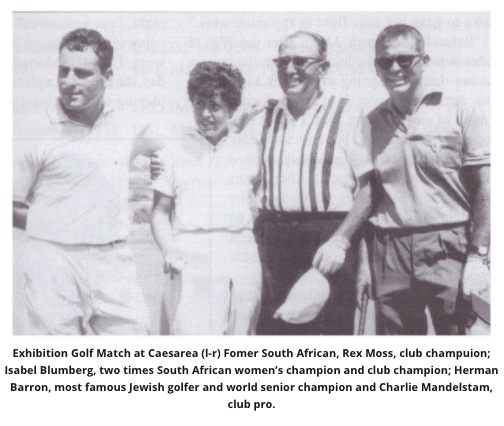“This is no place for a Jewish boy from South Africa,” muttered Charlie Mandelstam standing below deck on his first day on board Israel’s first navy warship, the Eilat.
Charlie could hear the rat-a-tat-tat of gunfire above as an Egyptian spitfire strafed the upper deck and the bridge. A non-Jewish volunteer from Sweden, Nils Elwing was killed while six other crew members were injured. This was the ‘Israeli Navy’s’ first loss of life in combat
 Charlie had only been in Israel ten days. He had spent a few years in the South African navy during WWII in convoy runs between Mombasa, Madagascar and the Seychelles and saw no action, “and here I was on my first day in the Israeli navy, and a fellow shipmate already lay dead on the deck.”
Charlie had only been in Israel ten days. He had spent a few years in the South African navy during WWII in convoy runs between Mombasa, Madagascar and the Seychelles and saw no action, “and here I was on my first day in the Israeli navy, and a fellow shipmate already lay dead on the deck.”
‘Roman Holiday’
A month earlier, Charlie found himself on a plane to Rome with other South Africans who had been recruited as volunteers to fight in the newly independent Israel’s first war of survival. “Sid Cohen [ace fighter pilot] and other South African pilots were on the flight as well, but they were all taken to Czechoslovakia to fly Messerschmitts to Israel while Bert Dinn, an air-gunner and I stayed in Rome waiting further instructions. When we arrived in Rome, we were told by our contact man not to disclose that we were headed for Palestine. On the first night in the hotel bar, we told the TWA staff and aircrew stationed at the hotel that we were on our way to the 1948 Olympic Games in London, and were waiting for the next available seats on a flight. We thought this might dispel any suspicion.”
After a week “of playing golf and hanging out at the bar, we were picked up by a bus and taken to an airfield in Rome where we were met by a representative from the Jewish Agency. But the plane was overloaded, and being the two least important people, we were left behind to resume our ‘holiday’!”
Returning to their hotel, “we told the night porter that there was no seats available on the flight to London, and that we needed our room back. The night porter pulled us aside and asked: “What are you rushing to Palestine for? You could get yourself killed. Stay here and have a good time.” So much for secrecy; apparently the whole of Rome knew where we were sneaking off to!”
Off to War
After a few more weeks playing golf, Charlie finally caught a place on a plane bound for Israel. As Lydda – where the national airport was situated – was still in Arab hands, “our plane landed in a small airport north of Haifa.” Charlie, still smarting from his time spent partying in Rome, “was tickled that I then found myself on a bus to Tel HaShomer with young girls from Haifa who had been drafted into the new armed forces.” But on that ‘front’, Charlie laments, “I made no progress; not for want of trying.” From the bus windows, “we could see the troop movements towards Tel Aviv.”
Ten days later, Charlie was assigned to the Eilat anchored off Tel Aviv. A former US Coast Guard Cutter called the Northland, it had been converted to bring across illegal immigrants and was then turned into a patrol boat – one of the three ships in the new Israeli navy. The Eilat ran a course patrolling the waters between Haifa and Gaza. “One night, I went with two American friends of mine from the ship to a bar frequented by merchant seaman. The three of us were sitting having beers when in walked an Englishman who told us amazing stories about his unit in the Negev operating behind Egyptian lines, attacking their convoys at night. This got the Americans all fired up and they decided that they wanted in on this action. So, returning to ship, they said goodbye to our captain – something like, “Thanks very much; it’s been nice knowing you.” Everything was very casual in those days’ including moving from the navy to the infantry in times of war.”
Charlie at Sea
A short while later, Charlie was transferred to a sub-chaser, called the Noga. “It was only called a sub-caser because it was the only ship with radar. Other than this, it did not have any anti-submarine equipment. An American friend of mine aboard ship got the address of some girls from kibbutz Maagan Michael who were stationed in Rehovot. We got to know them and they used to tease us, “You guys came all the way from the States and South Africa to have a good time sailing between Haifa and Gaza? Why don’t you join a real fighting unit!”
We could not wait for the opportunity to brag in the future. That opportunity arose soon.
 A short while after, “we were in the thick of it.” By “thick of it”, Charlie meant the famous encounter with the Egypt’s flagship the Emir Farouk.
A short while after, “we were in the thick of it.” By “thick of it”, Charlie meant the famous encounter with the Egypt’s flagship the Emir Farouk.
The Emir Farouk moved with two ships for escort, including a minesweeper, meaning that the small Israel Navy could not sink it by conventional methods. Israel’s Prime Minister, David Ben Gurion had authorized the mission, and a complex plan was prepared.
Charlie – in charge of the two 20-mm guns on the Noga – explains: “Our main task was to tempt the Emir Farouk out of Gaza harbour.”
Once this was achieved, “Four speedboats, three of them home-made torpedo boats, were launched from our sister ship, the Ben Hecht. When they got near the Emir Farouk, and its accompanying mine-sweeper, our guys jumped safely into the water, and the torpedo boats exploded on impact, sinking both enemy ships. All I really saw of the whole thing was the explosion in the distance on board the Noga, but we couldn’t wait to tell the girls of how we sunk those enemy ships.”
However, it did not turn out as planned.
The guys who had been on the torpedo boats “the real heroes of the story, were friends of the girls from Maayan Baruch!”
Golf and Girls
All this was a far cry from Charlie’s small hometown of Standerton, 160 kilometres east of Johannesburg. He came from neither a Zionist nor a religious background. “However, we were reading in the press about the Jewish struggle in Palestine, and it fascinated us. I had an elder brother who had been a POW in Italy during WWII. We both felt that the creation of the State of Israel was vital, and that our family should be represented in the struggle. Only one of us could go as someone had to stay with our widowed mother and run the family business. At that time, all I was interested in was golf and girls and I certainly did not fancy the responsibility of running a business, so I volunteered. When my mother found out that I was going, she went to the Zionist Federation and gave them hell. She had sent her two sons to fight the Nazis and she was not prepared to have her sons fight any more wars.”
Returning to South Africa after Israel’s War of Independence, “I had a hard time convincing my mother that I was going back to Israel to live. In truth, I never went to Israel with the intention of staying there. But first impressions mean a lot. I had been so warmly received while serving on the ships, wined and dined by hospitable locals that Balfour Street in Haifa, felt more like home than Piet Retief Street in Standerton. I belonged; Israel was home. I soon realized this was the only place where I would live.”
 On returning to Israel, Charlie joined Moshav Habonim where many of his shipmates and other South Africans had settled. “It wasn’t like going to a strange place, although conditions were pretty primitive. There was no running water and the nearest toilet was a 100 metres away. Within a few years, we had a dairy and vermiculite factory. We were the first to introduce sweet corn into this country. That was Solly Osrin’s idea. I used to work in the fields and brought feed for the dairy.”
On returning to Israel, Charlie joined Moshav Habonim where many of his shipmates and other South Africans had settled. “It wasn’t like going to a strange place, although conditions were pretty primitive. There was no running water and the nearest toilet was a 100 metres away. Within a few years, we had a dairy and vermiculite factory. We were the first to introduce sweet corn into this country. That was Solly Osrin’s idea. I used to work in the fields and brought feed for the dairy.”
However, what was catching Charlie’s eye was a long pair of attractive legs that belonged to Lucy who milked the cows early in each morning. “They were beautiful; still are,” he said chuckling in this interview, a few years before his passing. Charly married Lucy and eventually left Habonim in 1960.
On Course
Charlie had heard that there was a golf course being opened in Caesarea and applied for a job there. “I was given a few clubs and asked to coach a complete beginner so they could see how well I knew my game. I succeeded in passing the test, and was given the job – only temporarily! Despite my mother’s warning – ‘Fun golf ken men machen a leben’ (From golf you cannot make a living) – I remained on for the next 35 years. In those early years, a high percentage of the golfers at Caesaria were movie stars, tourists and diplomats.” Some of the glamorous players Charlie rubbed shoulders with either on the course or at the 19th hole were – Zubin Mehta, Danny Kaye, Kirk Douglas, Frank Sinatra, Sean Connery, Mickey Rooney and Peter Lawford.
Charlie recalls a game he played with the diplomats, Asst. Secretary of State, Joseph Sisco – who played a major role in Secretary of State Henry Kissinger‘s shuttle diplomacy in the Middle East and whose career in the State Department spanned five presidential administrations – and Alfred Leroy “Roy” Atherton Jr.
 “While both top diplomats,” say Charlie, “they were lousy golfers.”
“While both top diplomats,” say Charlie, “they were lousy golfers.”
That night after the game, “I got a call from Ted Lurie, the editor of The Jerusalem Post asking, “What were the scores?” I politely skirted the question. That Sunday, the paper ran a piece about Sisco and Atherton playing with the local pro, Charlie Mandelstam who wouldn’t divulge the scores. On Monday, I got a call from Sisco telling me he had just called Abba Eban suggesting he recruit me into the diplomatic corps!”
Charlie, who retired in 1996, was an adventurous young man when he arrived in Israel at a time of war to patrol these turbulent waters. Captivated by the land and its people, and particularly one pair of “gorgeous legs”, he left his mark. Asked how he would like to be best remembered, Charlie’s reply:
“Israel’s first golf professional in 4000 years!”

